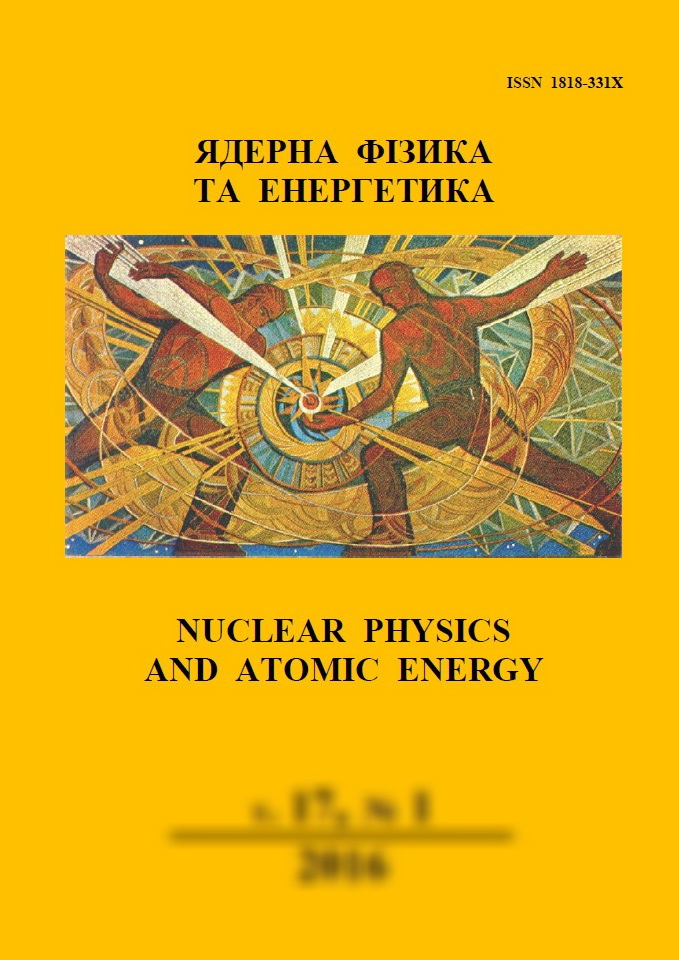 |
Ядерна фізика та енергетика
Nuclear Physics and Atomic Energy
ISSN:
1818-331X (Print), 2074-0565 (Online)
Publisher:
Institute for Nuclear Research of the National Academy of Sciences of Ukraine
Languages:
Ukrainian, English, Russian
Periodicity:
4 times per year
Open access peer reviewed journal
|
Nucl. Phys. At. Energy 2017, volume 18, issue 3, pages 230-237.
Section: Nuclear Physics.
Received: 29.12.2016; Accepted: 12.10.2017; Published online: 28.12.2017.
 Full text (ru)
Full text (ru)
https://doi.org/10.15407/jnpae2017.03.230
Application of time resonances' method for analysis of inclusive spectra in high-energy nuclear reactions
S. O. Omelchenko*, V. S. Olkhovsky
Institute for Nuclear Research, National Academy of Sciences of Ukraine, Kyiv, Ukraine
*Corresponding author. E-mail address:
omelchenkosa@kinr.kiev.ua
Abstract:
It is shown that the exponential decrease of the energy spectra of fragments with energy growing, which does not depend on the type of fragments, targets, projectiles and their energies, and which sometimes is accompanied by slight oscillations, can be explained by the phenomenon of time resonances. These time resonances correspond to decay of intermediate excited nuclear composite system. Inclusive spectra for р and 3Не in high-energy nuclear reactions 20Ne + U → p + Х (2.1 GeV/nucleon) and 20Ne + U → 3Не + Х’ (2.1 GеV/nucleon) are calculated.
Keywords:
exponential decreasing of the inclusive spectra, time resonances, non-exponential decay of stable nuclear clots.
References:
1. J. Gosset et al. Central collisions of relativistic heavy ions. Phys. Rev. C 16 (1977) 629.
https://doi.org/10.1103/PhysRevC.16.629
2. G. Westfall et al. Energy spectra of nuclear fragments produced by high-energy protons. Phys. Rev. C 17 (1978) 1368.
https://doi.org/10.1103/PhysRevC.17.1368
3. J. Cumming et al. Spallation of copper by 80-GeV 40Ar ions. Phys. Rev. C 17 (1978) 1632.
https://doi.org/10.1103/PhysRevC.17.1632
4. S. Kaufman, E. Steinberg. Cross-section measurements of nuclides formed by the reaction of 0.20 - 6.0 GeV protons with 197Au. Phys. Rev. C 22 (1980) 167.
https://doi.org/10.1103/PhysRevC.22.167
5. D. Fortney, N. Porile. Angular distributions of Sc fragments from the interaction of 238U with 0.8 U with 0.8 - 400 GeV protons. Phys. Rev. C 21 (1980) 2511.
https://doi.org/10.1103/PhysRevC.21.2511
6. A Sandoval et al. Spectra of p, d, and t from relativistic nuclear collisions. Phys. Rev. C 21 (1980) 1321.
https://doi.org/10.1103/PhysRevC.21.1321
7. P. Danielewicz, Q. Pan. Blast of light fragments from central heavy-ion collisions. Phys. Rev. C 46 (1992) 2002.
https://doi.org/10.1103/PhysRevC.46.2002
8. K. Izumo, H. Araseki. Time compound nucleus for high-energy nuclear reactions. Progr. Theor. Phys. 69 (1983) 158.
https://doi.org/10.1143/PTP.69.158
9. R. Alba et al. On the origin of fast proton emission in intermediate heavy ion collisions. Phys. Lett. B 322 (1994) 38.
https://doi.org/10.1016/0370-2693(94)90488-X
10. V.S. Olkhovsky, M.E. Dolinska, S.A. Omelchenko. The Possibility of Time Resonance (Explosion) Phenomena in High-Energy Nuclear Reactions. Central Europ. J. Phys. 4(2) (2006) 223;
https://doi.org/10.2478/s11534-006-0008-z
V.S. Olkhovsky, S.A. Omelchenko. Joint Time-Evolution and Statistical Energy-Resonance Analysis of High-Energy Nuclear Collisions and Possible Phenomena of Time Resonances. Proc. of Intern. Symp. on Large-Scale Collective Motion of At. Nuclei, Brolo, Messina, Italy, 15 - 19 Oct. 1996 (World Sci., 1997) p. 421.
11. V.S. Olkhovsky, M.E. Dolinska, S.A. Omelchenko. Phenomena of Time Resonances Explosions for the Compound-Clot Decays in High-Energy Nuclear Reactions. arXiv:0902.2665 [nucl-th] (2009) 15 p.;
https://arxiv.org/abs/0902.2665
V.S. Olkhovsky, M.E. Dolinska, S.A. Omelchenko. On new experimental data manifesting the time resonances (or explosions). Central Europ. J. Phys. 9(4) (2011) 1131.
https://doi.org/10.2478/s11534-011-0009-4
12. V.S. Olkhovsky. On Time Resonances (Explosions) in High-Energy Nuclear Collisions. Open Access Library Journal 1 (2014) e886, 12 p.
http://dx.doi.org/10.4236/oalib.1100886
13. J. Gosset, J.I. Kapusta, G.D. Westfall. Calculations with the Nuclear Firestreak Model. Phys. Rev. C 18 (1978) 844.
https://doi.org/10.1103/PhysRevC.18.844
14. A.I. Вaz’, A.M. Perelomov, Ya.B. Zel’dovich. Scattering, Reactions and Decays in Non-relativistic Quantum Mechanics (Jerusalem: Israel Program for Scientific Translations, 1969).
Google Books
15. Yu. Prilepsky, V. Shmonin. On the Mechanism of Cumulative Proton and Nuclear Fragment Production. Acta Phys. Polon. B 18 (1987) 729.
http://www.actaphys.uj.edu.pl/fulltext?series=Reg&vol=18&page=729
